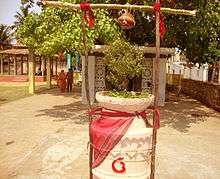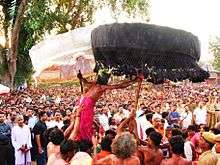Pana Sankranti
Pana Sankranti, (Odia: ପଣା ସଂକ୍ରାନ୍ତି) also known as Maha Vishuba Sankranti,[1][2] is the traditional new year day festival of Buddhists and Hindus in Odisha, India.[3][4][5] The festival date is set with the solar cycle of the lunisolar calendar, as the first day of the traditional solar month of Mesha. This is identical to the purnimanta system of lunar month Baisakh (on Indian national system, it is the 24th day of Chaitra).[2] It therefore almost always falls on 14 April every year on the Gregorian calendar.[6]
| Pana Sankranti | |
|---|---|
 Danda nata, dedicated to the mother goddess starts on Pana Sankranti. | |
| Official name | Pana Sankranti , Mahavishuva or Odia Nua Barsa |
| Also called | Maha Bisuba Sankranti |
| Observed by | Odia people |
| Type | Buddhists, Hindu |
| Significance | New Year |
| Celebrations | Meru Jatra, Jhaamu Jatra, Chadak Parba |
| Observances | Pujas, processions, Dalma, Khechudi and Bela Pana. |
| Date | 1 Vaisakha (Odia calendar, solar system) |
The festival is celebrated with visits to Shiva, Shakti, or Hanuman temples, as the day is considered to be the birthday of Hanuman.[7] People take baths in rivers or major pilgrimage centers. Communities participate in mela (fairs), watch street dance or acrobatic performances. A notable climax of the social celebrations is fire-walk, where volunteers sprint over a bed of burning coal while being cheered with music and songs.[2] Feasts and special drinks such as a chilled sweet mango-milk-yoghurt-coconut drink called Pana is shared, a tradition that partly is the source of this festival's name.[7][2]
Pana Sankranti is similar to new year festivals observed by Hindus elsewhere such as Vaisakhi (north and central India), Bihu (Assam), Pohela Boishakh (Bengal) and Puthandu (Tamil Nadu).[6][8]
Observances

In the Odia tradition, the Pana Sankranti is believed to be the birthday of the Hindu deity Hanuman, whose loving devotion to Vishnu avatar Rama in Ramayana is legendary. His temples, along with those of Shiva and Surya (sun god) are revered on the new year.[7]
Hindus also visit Devi (goddess) temples on Pana Sankranti. The temples include Taratarini Temple near Brahmapur, Odisha in Ganjam, Cuttack Chandi, Biraja Temple, Samaleswari temple and Sarala Temple. At Sarala Temple the priests walk on hot coals in the fire-walking festival, Jhaamu Yatra. At the Maa Patana Mangala Temple in Chhatrapada, Bhadrak, the Patua Yatra festival is held from 14 April to 21 April. In Northern Odisha, the festival is known as Chadak Parva. In Southern Odisha, the Meru Yatra festival is celebrated as the end of the month-long Danda nata dance festival. Thousands of devotees gather at the Shakti Pitha shrine in the Taratarini Temple because it is one of the auspicious days during the Chaitra Yatra. People from all over the state eat festive chhatua and drink Bel Pana to mark the occasion.
Main festival
Ghantapatuas are traditional male folk artistes from the Odisha that perform the art form "Jhama nata" during Pana Sankranti. They generally perform in a group of two or four wearing dresses that resemble women's clothing.

Danda nata that is performed during this festival celebration is one of the most ancient forms of performance art of the region. The opening ritual begins in the middle of Chaitra (March - April). The performers, also known as Dandua, take dip in a village pond and walk/run over hot charcoals while performing the art. After performing danda nata they also perform jala dandaby dipping themselves in deep water for a short while. These performances symbolize the liberation from physical pain.
Uda Jatra (Uda Parba) is a traditional tribal festival similar as danda nata where iron nails (12-16 inch) hammered in the back of the devotees and tagged with a rope.
Using this rope, the devotees are hanged and swinged around a wooden pillar. This festival is mainly celebrated in the northern part of Odisha specially in many tribal regions of Keonjhar and Mayurbhanj districts.
Related holidays
This new year day is celebrated elsewhere by other names. It is called Vaisakhi by Hindus and Sikhs in north and central India, which too marks the solar new year.[9][10][11] The same day every year is also the new year for many Buddhist communities in parts of southeast Asia such as Myanmar, Sri Lanka and Cambodia, likely an influence of their shared culture in the 1st millennium CE.[11] Some examples include:
- Vishu in Kerala
- Vaisakhi in central and north India
- Poila Boishakh in West Bengal and Tripura, as well as Bangladesh
- Rongali Bihu in Assam
- Bikram Samwat/Vaishak Ek in Nepal
- Aluth Avuruthu in Sri Lanka.[12]
- Songkran in Thailand
- Chol Chnam Thmey in Cambodia
- Songkan/Pi Mai Lao in Laos
- Thingyan in Burma
However, this is not the universal new year for all Hindus. For some, such as those in and near Gujarat, the new year festivities coincide with the five day Diwali festival. For many others, the new year falls on Ugadi and Gudi Padwa, which falls a few weeks earlier.[11]
See also
References
- Orissa (India). Orissa District Gazetteers: Ganjam. Superintendent, Orissa Government Press.
- Lynn Foulston; Stuart Abbott (2009). Hindu Goddesses: Beliefs and Practices. Sussex Academic Press. pp. 178–181. ISBN 978-1-902210-43-8.
- Maha Vishuba Sankranti Odisha celebrates Maha Vishuba Sankranti with Fervor
- Classic Cooking of Orissa. Danda Nata. Allied Publishers. pp. 26–. ISBN 978-81-8424-584-4. Retrieved 13 April 2012.
- Indira Gandhi National Centre for the Arts (1995). Prakr̥ti: Primal elements, the oral tradition. Meru Day, Meru Sankranti. Indira Gandhi National Centre for the Arts. p. 172. ISBN 978-81-246-0037-5. Retrieved 13 April 2012.
- J. Gordon Melton (2011). Religious Celebrations: An Encyclopedia of Holidays, Festivals, Solemn Observances, and Spiritual Commemorations. ABC-CLIO. p. 633. ISBN 978-1-59884-206-7.
- Jyoshnarani Behera (1997). Political Socialization of Women: A Study of Teenager Girls. Atlantic Publishers. p. 79. ISBN 978-81-85495-21-7.
- Kalyan Kumar Dasgupta; P. K. Mishra (1996). Aspects of Indian history and historiography: Professor Kalyan Kumar Dasgupta felicitation volume. World wise "vishuba sankranti". Kaveri Books. p. 111. ISBN 978-81-7479-009-5. Retrieved 13 April 2012.
- "BBC - Religion: Hinduism - Vaisakhi". BBC. Retrieved 22 January 2012.
- Crump, William D. (2014), Encyclopedia of New Year's Holidays Worldwide, MacFarland, page 114
- Karen Pechilis; Selva J. Raj (2013). South Asian Religions: Tradition and Today. Routledge. pp. 48–49. ISBN 978-0-415-44851-2.
- Peter Reeves (2014). The Encyclopedia of the Sri Lankan Diaspora. Didier Millet. p. 174. ISBN 978-981-4260-83-1.
Further reading
- Robert Sewell (15 March 2010). The Indian Calendar – With Tables for the Conversion of Hindu and Muhammadan Into A. D. Dates, and Vice Versa. Read Books Design. pp. 149–. ISBN 978-1-4455-3119-9. Retrieved 10 November 2011.

